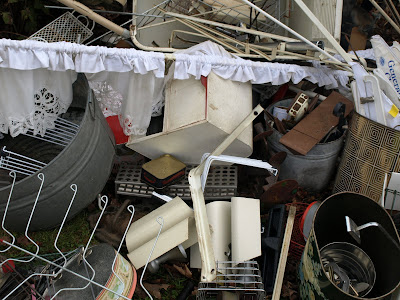
A few months ago a young forest management specialist stopped by to offer us his services. We declined, but it was a pleasant day, and Ed and I stood in the driveway talking to him for a while. Eventually the conversation moved from proper timber harvest techniques to our plans for the farm.
"You guys have a tractor?" he asked.
"Yeah," said Ed.
"What kind?"
"A Kubota."
"Oh, wrong color!"
His John Deere cap announced where his allegiances lay, and the phrase he used referred to the distinct hues the major tractor companies use to distinguish their products from one another. There is Kubota orange, Ford/New Holland blue, Case/IH red, and of course John Deere green.
But the more I look at modern tractors, the more I am struck by how much, at least around the base of the loader, these proud colors are obscured by the warning labels that are pasted everywhere, like an overseas letter posted with the remainder of twenty different rolls of stamps.
This warns that leaving the engine in gear will not stop the tractor from rolling - the parking brake must be engaged. I met someone who had this happen, and his tractor went through a fence and ended up in a gully.
This is an obvious liability thing. The step is broad, almost a platform, and the fender has this great handle so perfectly placed that it invites having a friend or sibling ride along.

These warn of hitting electric lines with the loader, of dropping a load back onto the driver, and of rolling the tractor. I recently read that rolling tractors is still the leading cause of accidental death among farmers, despite state subsidized programs to retrofit old machines with rollover protection systems.
This one strikes me as counterproductive. I hope my tractor always starts, but if it doesn't some morning I will now be tempted to go online to find out how to short across the starter terminals.

The first two warnings - don't carry people in the bucket, and take pains to not get crushed by the bucket - are fairly commonsensical, though they are notable for their creative use of the hapless silhouette warning label man. The third label is terrifying. Perhaps it is well known in certain circles that hydraulic hoses can leak with such force that they can inject fluid deep enough into flesh to cause gangrene, but it was news to me.
This is the ultimate tractor warning label, in that it is both obvious and foreign; it is obvious that an exposed drive shaft spinning at 540 RPM and powered by a 70 horsepower diesel engine should be treated with care, but it is foreign in that almost all such blatantly dangerous situations have been removed from American life. It also has warning label silhouette man meet his most gruesome end.
As a novice to farming, these slight dangers have been among the most interesting aspects. It is not just a matter of whether I am foolish enough to drive my tractor, bucket upraised, into overhead power lines. In college all I had to worry about was crossing the street. Since then my riskiest activity has been driving. (And my car doesn't have a loader on it, so I couldn't hit the overhead lines if I wanted to.) But this morning our bull fell behind the cows, and when he saw them eating in the new break of pasture he got excited and galloped the last twenty yards. I could only stand and watch and wonder what I would do if he ever ran at me.
Unfortunately, he doesn't have any labels at all on him.
-Garth

































